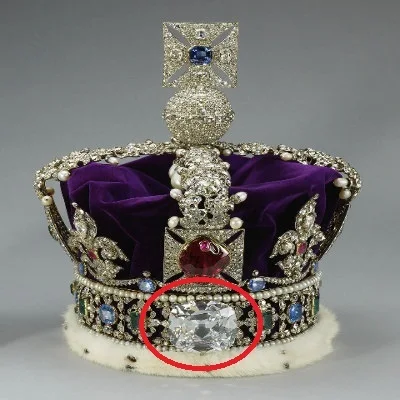The Koh-i-Noor also spelt Kohinoor and Koh-i-Nur, is one of the largest cut diamonds in the world, weighing 105.6 carats (21.12 g). It is part of the British Crown Jewels.
Probably mined in Kollur Mine, India, during the period of the Delhi Sultanate, there is no record of its original weight – but the earliest well-attested weight is 186 old carats (191 metric carats or 38.2 g). The diamond was part of the MughalPeacock Throne. It changed hands between various factions in south and west Asia, until being ceded to Queen Victoria after the British annexation of the Punjab in 1849.
Originally, the stone was of a similar cut to other Mughal-era diamonds, like the Darya-i-Noor, which are now in the Iranian Crown Jewels. In 1851, it went on display at the Great Exhibition in London, but the lacklustre cut failed to impress viewers. Prince Albert, husband of Queen Victoria, ordered it to be re-cut as an oval brilliant by Coster Diamonds. By modern standards, the culet (point at the bottom of a gemstone) is unusually broad, giving the impression of a black hole when the stone is viewed head-on; it is nevertheless regarded by gemologists as "full of life".
Because its history involves a great deal of fighting between men, the Koh-i-Noor acquired a reputation within the British royal family for bringing bad luck to any man who wears it. Since arriving in the UK, it has only been worn by female members of the family. Victoria wore the stone in a brooch and a circlet. After she died in 1901, it was set in the Crown of Queen Alexandra, wife of Edward VII. It was transferred to the Crown of Queen Mary in 1911, and finally to the Crown of Queen Elizabeth (later known as the Queen Mother) in 1937 for her coronation as Queen consort.
Today, the diamond is on public display in the Jewel House at the Tower of London, where it is seen by millions of visitors each year. The governments of India, Pakistan, Iran, and Afghanistan have all claimed rightful ownership of the Koh-i-Noor and demanded its return ever since India gained independence from the UK in 1947. The British government insists the gem was obtained legally under the terms of the Last Treaty of Lahore and has rejected the claims.
The diamond may have been mined from Kollur Mine, a series of 4-metre (13 ft) deep gravel-clay pits on the banks of Krishna River in the Golconda (present-day Andhra Pradesh), India. It is impossible to know exactly when or where it was found, and many unverifiable theories exist as to its original owner.
The Koh-i-Noor made its first appearance in popular culture in The Moonstone (1868), a 19th-century British epistolary novel by Wilkie Collins, generally considered to be the first full length detective novel in the English language. In his preface to the first edition of the book, Collins says that he based his eponymous "Moonstone" on the histories of two stones: the Orlov, a 189.62-carat (37.9 g) diamond in the Russian Imperial Sceptre, and the Koh-i-Noor. In the 1966 Penguin Books edition of The Moonstone, J. I. M. Stewart states that Collins used G. C. King's The Natural History, Ancient and Modern, of Precious Stones … (1865) to research the history of the Koh-i-Noor.
The Koh-i-Noor also features in Agatha Christie's 1925 novel The Secret of Chimneys where it is hidden somewhere inside a large country house and is discovered at the end of the novel. The diamond had been stolen from the Tower of London by a Parisian gang leader who replaced it with a replica stone.
For More Information- Koh-i-Noor








No comments:
Post a Comment
Stay updated with our blog for more quality content! Your feedback is appreciated. Contact us at harshrex@outlook.com with any suggestions.